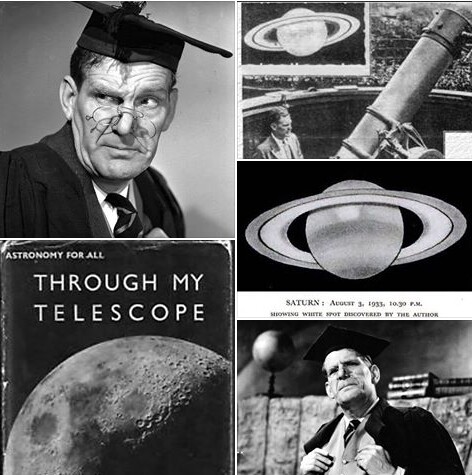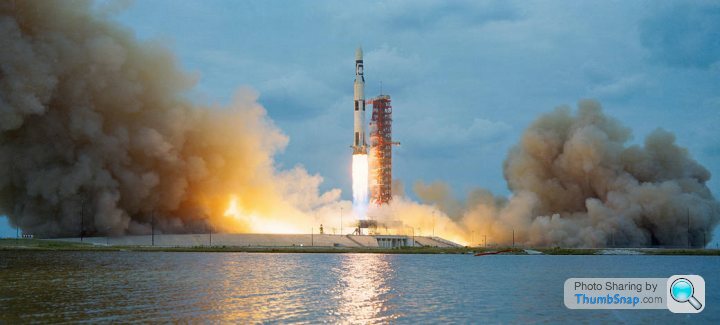Saturn V anecdote
Discussion

Stephen Coester...
Before AS-505 Apollo 10 which was the only Apollo to launch from LC-39B we were filling the Pad B 850,000 gallon LH2 tank for the very first time from empty. You can see the fill manifold in the foreground to the right. I was the engineer in charge. This involved offloading an endless stream of 5000 gallon or 10000 gallon tanker trucks. The smaller ones looked like any cylindrical tanker you would see on the road. The big ones were rectangular looking more like a regular trailer. We had five ports so could hook up five tankers at a time. We started flowing through the fill manifold by opening the main LH2 tank valve and the five individual manifold valves and by pressurizing the tankers which forced the LH2 out. We had done this dozens of times on Pad a and had the procedure down pat. I was standing by the long 4" vacuum jacketed manifold when suddenly I hear a pop and saw the line start bending upward about six inches. I immediately had the tankers vent their pressure, closed the main LH2 tank valve and initiated a helium purge into the line to get rid of the flammable hydrogen gas and warm up the line. so much for filling up the LH2 tank. I went back to the engineering trailer and pulled out the manifold drawings for Pad B. They were identical to Pad A except for one seemingly insignificant difference. The designer had changed the material of the pressure carrier or inner pipe of the vacuum jacketed lines from Inconel 718 to 316 stainless steel. Inconel has almost negligible shrinkage at -423 degree temperature while stainless steel can shrink two inches over a forty foot section (if I remember correctly). They had used the same outer jacket bellows that they had used on Pad A and they just weren't adequate on Pad B. So as the inner line shrank the bellows compressed until they got squeezed so much they cracked. This caused air to be sucked into the vacuum jacket and freezing against to cold inner pipe. As the pipes warmed up from the helium purge the solid frozen air expanded rapidly causing big clouds of vapor around the broken pipe. Pretty dramatic and frightening to me standing there with a broken system. The system was down for several weeks while the pipe was cut apart and much larger outer line bellows were installed. Finally with much trepidation I tried again and successfully filled the LH2 tank. It successfully supported AS-505, Skylab 2, 3 and 4 and Apollo Soyez and many Space shuttle launches.
Beati Dogu said:
I bought the NASA Saturn V Haynes manual the other day.  Honestly, it exits. Only £6 in The Works it was too.
Honestly, it exits. Only £6 in The Works it was too.
It's actually really interesting and shows the development and construction of the rocket. Highly recommended.
https://haynes.com/en-gb/nasa-saturn-v-owners-work...
It is an excellent book - I hope the same author writes one about the Saturn 1 and 1B Honestly, it exits. Only £6 in The Works it was too.
Honestly, it exits. Only £6 in The Works it was too.It's actually really interesting and shows the development and construction of the rocket. Highly recommended.
https://haynes.com/en-gb/nasa-saturn-v-owners-work...
Heads up - a Haynes manual for Skylab has recently been released
https://www.amazon.co.uk/Skylab-Owners-Workshop-Ma...
https://www.amazon.co.uk/Skylab-Owners-Workshop-Ma...

Stephen Coester - "I worked for Boeing in the liquid hydrogen group out under the big LH2 tank. Our responsibility was for the tank, piping and valves in the storage area and on the LUT up to the swing arms...and for performing the LH2 and RP-1 loading into the stages from the firing room. I've heard that some of the astronauts thought the worst part of the mission was the walk across the swing arm. In my youth I was terrified of heights, but between the rigors of the Naval Academy and working at KSC I got over it.
Arms 4, 5, 6 & 7 routed the LOX and LH2 to the S-II and S-IVB and GH2 from the stages along with other pneumatic and electrical functions. My LH2 responsibility ended at the entrance to the swing arms, but I still spent time climbing on them to inspect the LH2 lines."
Eric Mc said:
I'd also like to have a go at building a model of Skylab as it looked in orbit - so the book will be good for that too.
For the orbiting Skylab model I can recommend this http://www.spaceinminiature.com/books/simtr1.html for $6Good article dispelling some myths of the space age
https://this-space-available.blogspot.co.uk/2018/0...
https://this-space-available.blogspot.co.uk/2018/0...
Stephen Coester:
The LC-39 RP-1 tanks were buried in a grass covered bunker so you couldn't see them near the LH2 tank. Three large cylindrical tanks were in a huge concrete pit designed to hold any spilled RP-1. I don't know why they were then covered with dirt and grass. Next to this bunker was the RP-1 building which held all the pumps, valves, filters etc.
This building was protected by a foam fire protection system. The system could be actuated from the firing room or from a switch outside the building.
One day a mechanic was performing some mundane task out side the building and he removed the nuts from some piece of equipment. I guess in order not to misplace them he put them inside the metal shroud around the fire foam switch. When he was ready to reinstall the nuts he found he couldn't reach that last nut so he reached beneath the cover and pushed up which inadvertently pushed up the switch which activated the foam. We had never tested this system but it sure worked. The whole RP-1 building was filled with billowing white foam. And this foam was made from horse blood of all things and it stunk like dead horse. What a mess. Used the fire water hoses to clean up the mess. Then had to reverify that all of the mechanical and electrical equipment wasn't damaged by the foam.
The LC-39 RP-1 tanks were buried in a grass covered bunker so you couldn't see them near the LH2 tank. Three large cylindrical tanks were in a huge concrete pit designed to hold any spilled RP-1. I don't know why they were then covered with dirt and grass. Next to this bunker was the RP-1 building which held all the pumps, valves, filters etc.
This building was protected by a foam fire protection system. The system could be actuated from the firing room or from a switch outside the building.
One day a mechanic was performing some mundane task out side the building and he removed the nuts from some piece of equipment. I guess in order not to misplace them he put them inside the metal shroud around the fire foam switch. When he was ready to reinstall the nuts he found he couldn't reach that last nut so he reached beneath the cover and pushed up which inadvertently pushed up the switch which activated the foam. We had never tested this system but it sure worked. The whole RP-1 building was filled with billowing white foam. And this foam was made from horse blood of all things and it stunk like dead horse. What a mess. Used the fire water hoses to clean up the mess. Then had to reverify that all of the mechanical and electrical equipment wasn't damaged by the foam.
With the imminent descent of Tiangong 1 hitting the headlines, here's an interesting article about another piece of space debris which hit the news...
http://www.thespacereview.com/article/1195/1
http://www.thespacereview.com/article/1195/1
A bit off topic...
Today is the anniversary of the death, in Chelsea, London on 18 Apr 1949, of the English actor, comedian, entertainer and accomplished amateur astronomer William Thomson ‘Will’ Hay. As well as his many exploits, both on stage and in film, Will Hay is remembered as a dedicated and highly-respected amateur astronomer. A Fellow of the Royal Astronomical Society, he wrote the book Through My Telescope in 1935 and even constructed an observatory in his garden, the observations made from which included measuring the positions of numerous comets (with a micrometer he built himself) and discovering the Great White Spot on the planet Saturn in 1933.

Today is the anniversary of the death, in Chelsea, London on 18 Apr 1949, of the English actor, comedian, entertainer and accomplished amateur astronomer William Thomson ‘Will’ Hay. As well as his many exploits, both on stage and in film, Will Hay is remembered as a dedicated and highly-respected amateur astronomer. A Fellow of the Royal Astronomical Society, he wrote the book Through My Telescope in 1935 and even constructed an observatory in his garden, the observations made from which included measuring the positions of numerous comets (with a micrometer he built himself) and discovering the Great White Spot on the planet Saturn in 1933.

Another tale from Stephen Coester...
This story is from my Saturn V years with Boeing, but could be from anywhere. Time came for our yearly performance evaluations and our supervisor in the LH2 group called us together and told us the genius in HR wanted us to write our own evaluations. Apparently many of the engineers wrote that they were average, did their job to the best of their abilities, etc. Not me. I wrote that I was God's gift to aerospace, they couldn't launch without me, etc., etc. my boss called me in and asked if I seriously wanted to submit it that way. I told him no, i wanted his opinion of my performance. It got submitted so somewhere in the Boeing files is the most overblown performance evaluation ever.........
This story is from my Saturn V years with Boeing, but could be from anywhere. Time came for our yearly performance evaluations and our supervisor in the LH2 group called us together and told us the genius in HR wanted us to write our own evaluations. Apparently many of the engineers wrote that they were average, did their job to the best of their abilities, etc. Not me. I wrote that I was God's gift to aerospace, they couldn't launch without me, etc., etc. my boss called me in and asked if I seriously wanted to submit it that way. I told him no, i wanted his opinion of my performance. It got submitted so somewhere in the Boeing files is the most overblown performance evaluation ever.........
Boeing engineers work inside the oxygen tank of the S-ICfirst stage of the Saturn 5. The "ribs" on the walls of the tank limit the sloshing of the liquid oxygen, and the things in the foreground are anti-swirl vanes. In front of the workers are the helium cylinders for pressurising the fuel tank.



May 7, 1972….Forty-six people from the North Island Naval Air Station near San Diego, California are hospitalized for 24-48 hours after a ground service cart exploded from over pressurization, which at the time was removing residual Reaction Control System propellant and the Freon used to flush the system from Apollo 16’s Command Module. Those hospitalized suffered from the exposure and inhalation to the toxic propellant and some were kept overnight as a precaution. The most seriously injured is a technician with a fractured knee from the ground service cart overturning on him. A hole is blown in the hangar roof 250 feet above, 40 windows are destroyed, two nearby aircraft are damaged and the Command Module sustains minor damage to an exterior panel. The CM was delivered to the Naval Air Station by the USS Ticonderoga after it was picked up at splashdown April 27, 1972.
(Personnel begin the deactivation process while onboard the USS Ticonderoga)
image: S72-36189
Prior to Apollo 16 leftover propellant had been vented during descent, but was blamed for the failure of one of Apollo 15's parachutes, hence the procedure was changed
Beati Dogu said:
MartG said:
Prior to launch, the Saturn 1B used for ASTP required its fins replacing due to cracks
I read somewhere that the fins on the Saturn V were deemed to be superfluous and would likely have been deleted from later models, had the programme continued.Gassing Station | Science! | Top of Page | What's New | My Stuff








